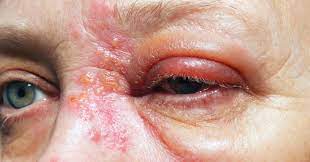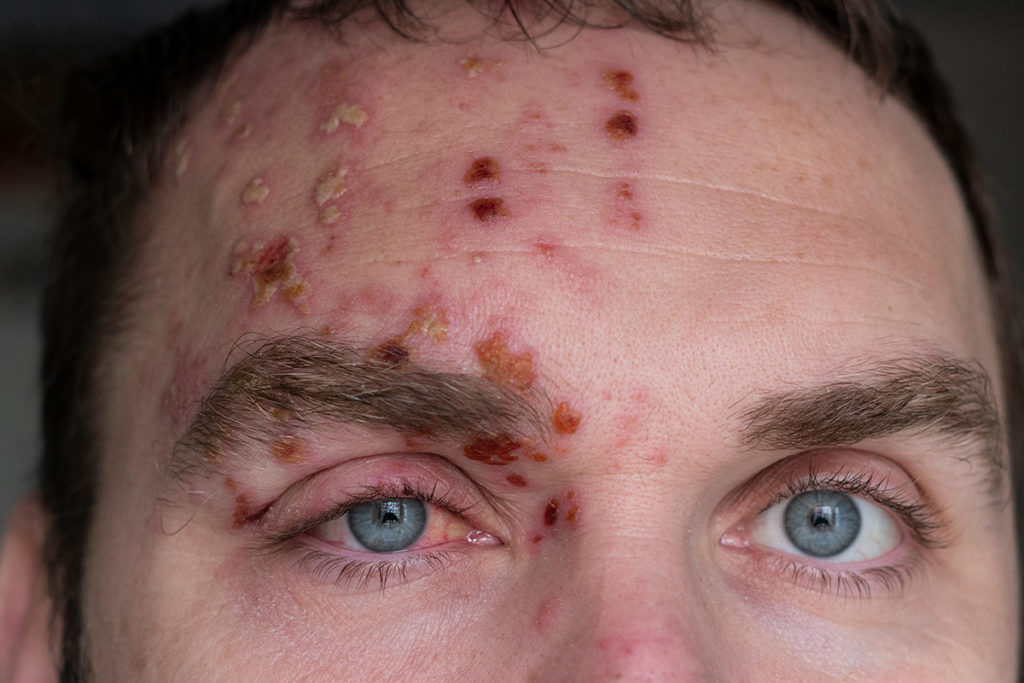Contents
What Is Shingles In Eye?

It is a disease that is caused by a virus. A strip of blisters is usually seen in this disease. Anti-viral drugs help in treating shingles.
The word ‘Shingles’ comes from a Latin word that has a belt as its meaning. It is a viral disease that leads to the formation of rashes on your skin as a result of painful acute inflammation of the nerve ganglia, which causes an eruption of the skin and the formation of a girdle around the body. It is caused by a virus namely Varicella-zoster virus which is also responsible for causing chickenpox in an individual. The shingles rash appears as a line of fluid-filled bristles that is seen on either side of the torso of the body.
In the eye, shingles appear as a rash that is seen in and around the eye. This type is called ophthalmic herpes zoster or herpes zoster ophthalmicus. In a patient who has already encountered chickenpox, this virus remains dormant inside the body but after a certain period of time, this virus reappears as shingles (rashes/blisters around the eye).
Symptoms of Shingles In Eye

If you have shingles in the eye, a rash will form on your eyelids, forehead, and perhaps on the tip or side of your nose. This rash may appear simultaneously with the skin rash or weeks after the skin bumps have gone away. Some people have symptoms only in their eyes.
As well as the rash, you may feel:
- Burning or stinging pain in your eyes
- Redness around the eyes
- Teary eyes or water
- Irritation of the eye
- Blurred vision
- Excessive sensitivity to light
You may also have swelling in parts of your eyes, such as:
- The eyelid of your eye
- The retina, which is the light-sensitive layer behind your eye
- Your cornea, which is a clear layer in front of your eye
If you have one or more of these symptoms, call your primary care physician or optometrist. The sooner you get treatment, the less likely you are to have long-term problems.
Causes of Shingles In Eye
Shingles is a disease that causes painful rashes on the body and sometimes on the face and is caused by the varicella-zoster virus. This is the same virus that causes smallpox. Once you have chickenpox, the virus stays in your system. It can also be remembered decades later as shingles.
- Virus – varicella zoster virus
- Sometimes due to stress as in stressful conditions, one’s immune system can be affected which allows the increase in viral attack.
Risk Factors For Shingles In Eye
Individuals who have previously encountered chickenpox disease during their childhood time are most likely to be affected with shingles as the virus shifts into a dormant state and lies in the nerve ganglia between the spinal cord and brain in an inactive form hidden from the immune system so that it can activate again in form of shingles. And also people who are also aged above 50 years are prone to get this disease, as their immune system tends to lose its efficiency.
People who are undergoing any treatments such as chemotherapy (used in treating cancer) and also people suffering from diseases such as HIV or AIDS i.e., diseases that require treatment that decreases the effect of the immune system in the body are subjected to shingles. Shingles also occur in pregnant women, premature infants.
- You are at a high risk of getting shingles if you have ever had chickenpox at a young age
- If you’re 50 years or older because your immune system is weakening as you grow older
- You have a weakened immune system due to a disease such as cancer, HIV infection, or AIDS
Shingles are very sensitive to other groups of people, including:
- Pregnant women
- Infants born prematurely
- People with weakened immune systems
Complications of Shingles In Eye

There are various complications related to shingles such as
- Postherpetic neuroglia: This condition is caused when the pain still remains even after the blisters are healed. Hence, this condition is called postherpetic neuroglia which is due to damage of nerve fibers that send pain messages from the skin to the brain. Due to confusion and damage caused by shingles state.
- Vision loss: When shingles infect the eye, they cause severe pain in and around the eye which can also cause fatal effects such as loss of vision and swelling of the eye, itchiness around the eye.
- Neurological problems: Shingles can cause acute inflammation so it can cause encephalitis i.e., inflammation of the brain or facial paralysis due to damage of nerves which lead to severe neurological problems.
- Skin problems: Improper treatment of blisters can lead to an increase in skin-related problems due to bacterial attacks upon opening of blisters.
The blisters or rashes which are formed due to shingles can be healed after the treatment. But one can experience the pain for many months whereas it takes weeks for the rashes to heal. This usually occurs when one is suffering from shingles around the eyes. In the early stages, a checkup must be performed regularly and after healing, in order to check for glaucoma or any eye-related problems, one must undergo an occasional check-up every 3 months.
Is Shingles Contagious?
- When a person who is never infected with chickenpox or did not take any chickenpox vaccine, must stay away from the person who is infected with shingles as it affects them also but the person will be infected with chickenpox, not shingles. Women who are pregnant must be extra cautious in order to prevent shingles.
- When a rash appears on the skin, try not to rubber and infect it.
- Wash your hands properly and maintain hygiene.
Effects of Shingles In Eye
Usually, it appears on the body surface but the appearance of rashes on eyelids is an effect of shingles. It is a severe condition. Rashes around the eye cause severe pain including throbbing pain and vision problems and watering of eyes and redness around the eye and appearance of blisters on the forehead and around the eyelids and either side of the nose. Not only that, but these rashes can also cause an increase in sensitivity towards light and blurry vision of the eye, and irritation and itchiness around the eye. Acute inflammation i.e., swelling of parts of the eye such as retina, eyelid as well as cornea is also one of the effects of shingles in the eye.
Prevention
The shingles vaccine does not give any guarantee that one will not be affected by it at all. It is only used to reduce the disease severity and decrease the risk of postherpetic neuroglia and other complications such as loss of vision. So, as the line goes that Prevention is better than cure, one must consider an option that is much favorable to them.
To prevent shingles, try to avoid close contact with anyone who has never had chickenpox. This is especially important during an infection when you have blisters on your skin. A person who has never had a chicken can get the varicella-zoster virus but will have an untreated chicken.
There are certain things that should be specially taken care of:
- Keep your rash covered to reduce the chances of spreading.
- Try to avoid scratching the rash.
- Wash your hands after touching the rash.
Diagnosis of Shingles In Eye
One can tell this disease by looking for blisters or rashes in and around the body and eye area. Constant pain, redness, and rashness, itchiness can help in the quick diagnosis of this disease. The fluid that oozes out after the opening of blisters is also helpful in the diagnosis of shingles
Usually, Shingles can be mistaken for other skin diseases or allergies, as they have similar symptoms and effects i.e, rash formation. Skin diseases such as hives, eczema, and psoriasis are often misjudged as shingles. So, one must consult a doctor in case of shingles.
The optometrist will examine:
- Cornea
- Lens
- Retina
- Other parts of your eye
They will look for inflammation and damage caused by the virus.
Treatment

Usage of antiviral drugs is required in the treatment of Shingles as they decrease the risk of disease and help in quick healing. Intake of these drugs within 3 days of rash appearance, acts most effectively. Some of the drugs which are suggested for treatment are
- Acyclovir(Zovirax)
- Famciclovir (Famvir)
- Valacyclovir (Valtrex)
Some Drugs for Shingles In Eye Treatment
- Anticonvulsant medicines like gabapentin
- Antidepressants like amitriptyline
- Colloidal oatmeal baths
- Cool compresses
- Medicated lotion
- Numbing medications like lidocaine
- Over-the-counter drugs like acetaminophen or ibuprofen
- Prescription painkillers like codeine.
- One of the treatments that help in relieving pain which is caused by shingles is Apple cider vinegar. This is a home remedy that is recommended to reduce the rashes and shingle’s pain as apple cider vinegar possesses some of the antiviral properties.
If Shingles are left untreated, they can be even more fatal. It can cause pneumonia, inflammation, stroke, and bacterial infections which increase the severity of the disease.
Vaccine For Shingles In Eye
Recently FDA approved Shingrix as an effective vaccine than Zostavax i.e, it is almost 90% more effective than the other vaccine. Shingrix provides protection from this disease for more than 5 years and also it is helpful for people who are aged above 50 suffering from shingles and also reduces the risk factors of shingles. Its dose is given in two doses in a time gap of two to six months.
In 10 to 20 percent of people with shingles, the rash appears in and around the eye. This type of shingles is also known as herpes zoster ophthalmicus. It can cause injury, loss of vision, and other long-term problems. You can prevent eye shingles and their problems with vaccination if you are over 50 years old.
The best way to treat your eyes is to visit your eye care professional and get your eyes checked regularly. He will be able to assess the best method of treatment for your eye ailment.
Visit our website Eyemantra.
To book an appointment call at +91-9711115191. Or mail us at [email protected].
Our other services include Retina Surgery, Specs Removal, Cataract Surgery, and many more.



